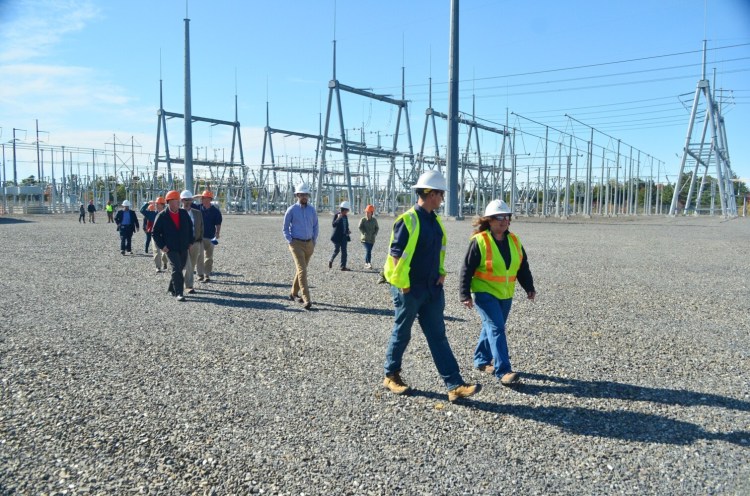WINDSOR — A $50 million high-technology system that is the largest of its kind in North America and helps keep the lights on and the power flowing throughout New England is located off a dirt road, off a back road, in this Kennebec County town.
Central Maine Power Co. officials, at an event last week at the normally unmanned Coopers Mills Substation at the end of a nondescript dirt entrance road off Maxcy Mills Road, touted the 17-acre substation’s static compensator, or STATCOM SVC Light, system. They said that when the system was installed in 2018, it was the largest in the world.
The system monitors voltage variations and power disruptions and makes adjustments to the grid in milliseconds to help prevent outages and enable faster restoration if there is an outage. The system takes electricity produced in Canada through Maine, and it’s distributed throughout New England
“It’s the largest of its kind in North America, we’re very proud of it,” said Doug Herling, CMP president and chief executive officer. “It’s making a strong grid for all of New England.”
The new system was added to a massive substation installed in Windsor in 2014, after ISO New England, the nonprofit corporation responsible for keeping electricity flowing in New England, determined the spot would be a good location and had the space to accommodate the project meant to help stabilize the region’s electrical grid.
Urban Standberg, a vice president for sales and marketing for the international firm ABB, which built the system, said it is, in effect, an insurance policy. When everything is working as it should, the station does nothing other than monitor the system, until it detects an issue that could cause it to become unstable, such as a change in reactive power flow.
“It minimizes the chances for blackouts,” Strandberg said. “What this device is doing is enabling the 3 million end-consumers in this region to have a more stable system.”
What the substation does for the community of Windsor, in addition to bringing power via massive transmission lines that cut a swath through town, is bring tax revenues.
Town Manager Theresa Haskell said in 2010, before the substation additions, it was valued for tax purposes at $10 million. In 2019, its value has increased to $153 million.
She said property and equipment taxes on the substation and distribution system provide nearly 49 percent of the town’s annual tax revenues.
Haskell said the site has not generated complaints from residents. The only noise it emits is a hushed humming within the site.
Other than one home visible from the station, she said it’s visible to one neighborhood, but only when the leaves are off trees or when the lights are on at the facility.
CMP class 1 substation worker Debra Simmons said, while leading a tour of the station, the lights of the facility are only on when workers are at the site performing maintenance.
Haskell said when the massive transformers for the substation were brought in, on 18-axle tractor-trailers, students at Windsor Elementary School got out of classes to see them go by. She joked that some of them were disappointed because they were expecting to see a different kind of transformers – those of the Transformers product line featuring toys that transform from vehicles or other mundane devices to robots.
The high-speed computers and other equipment that make up the STATCOM system look fairly unremarkable, with flashing lights and digital readouts similar to a super-sized IT room. They’re kept inside a nondescript building toward the rear of the complex, which elsewhere is covered in gray-painted transformers and other electrical system components, inside a locked room with cooling lines running throughout it to keep the system cool.
The system communicates with other substations elsewhere via fiber optics.
Adam Derosiers, manager of substation operations for CMP when the system was built, said normally the station is unmanned, and is monitored around the clock remotely from CMP’s headquarters on Edison Drive in Augusta.
Herling said that in the past, ensuring the level of stability in the grid brought by the STATCOM system would have required the construction of more transmission lines, meaning the new system lessens the power grid’s impact on the environment.
Comments are not available on this story.
Send questions/comments to the editors.



